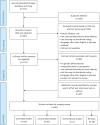Disordered eating and eating disorders in male elite athletes: a scoping review
- PMID: 33178441
- PMCID: PMC7642204
- DOI: 10.1136/bmjsem-2020-000801
Disordered eating and eating disorders in male elite athletes: a scoping review
Abstract
Background: Eating disorders (ED) and disordered eating (DE) among male elite athletes share some of the characteristics seen in female elite athletes and the population, but also exhibit some key differences.
Objective: Scoping review of ED and DE in male elite athletes.
Methods: In May 2020, a comprehensive systematic literature search was conducted for DE and ED in male elite athletes.
Results: We identified 80 studies which included 47 uncontrolled, 14 controlled studies, one interventional trial and 18 reviews.
Discussion: There was a wide range of definitions of DE and a high level of heterogeneity regarding competitive level, age and sport type. In adult male elite athletes, ED prevalence rates up to 32.5% were found, higher than in the general population. Prevalence was not higher in young/adolescent male elite athletes. The most frequently associated factor was competing in weight-sensitive sports. Male elite athletes tended to exhibit less body dissatisfaction than controls and were not always associated with DE. There were no studies looking at the prognosis or reporting an evidence-based approach for the management of DE in male elite athletes.
Conclusion: Existing literature indicates high prevalence of DE and ED in male elite athletes, with a wide range of aetiopathogenesis. There is a need for longitudinal studies to characterise the pathology and long-term outcomes, as well as develop standardised tools for assessment and treatments.
Keywords: Athlete; Eating disorders; Elite performance; Male; Review.
© Author(s) (or their employer(s)) 2020. Re-use permitted under CC BY-NC. No commercial re-use. See rights and permissions. Published by BMJ.
Conflict of interest statement
Competing interests: None declared.
Figures
References
-
- APA . Diagnostic and statistical manual of mental disorders: DSM-IV. Fourth edition. Washington, DC: American Psychiatric Association, Vol. 1994, 1994.
-
- Ewers SM, Halioua R, Jäger M, et al. Sports psychiatry and psychotherapy - disturbed eating behavior and eating disorders in high-performance sport. Dtsch Z Sportmed 2017;68:261–8. 10.5960/dzsm.2017.305 - DOI
Publication types
LinkOut - more resources
Full Text Sources


